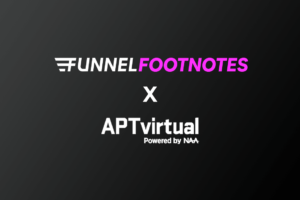Funnel Footnotes: APTVirtual
 Funnel footnotes are summaries of cool lessons, trends, and insights our team gains from multifamily industry events. We package up some of the things that inspire us and share that with you in a compact format for learning-on-the-go.
Funnel footnotes are summaries of cool lessons, trends, and insights our team gains from multifamily industry events. We package up some of the things that inspire us and share that with you in a compact format for learning-on-the-go.
Build A Bridge And Get Over It: Fostering Collaborative Workplaces
- Why have we, as an industry, always seemed to focus our career pathway training and operations in a manner that tends to push our team members into silos? While this practice may seem essential to helping one master their specific departmental craft, it pushes professionals towards developing professional tunnel vision.
- How do we avoid operating in silos? We need to give each department a holistic view of company goals. We waste time and resources when there is a communications breakdown.
- When operating in silos, employees feel they’re in the dark and are not buying into the organizational goals or getting the big picture. That can lead to resentment and subsequently inefficiencies through errors, wasted time, and wasted resources.
“When we don’t collaborate, we don’t get ground intelligence to make big decisions for the overall organization.”
- When we don’t collaborate, we don’t get ground intelligence to make big decisions for the overall organization.
- Promote inclusion — get insights from outside the silo. Create a feedback loop, e.g. internal Facebook page. Implement internal praise, a peer recognition program, and create opportunities to connect.
- Be open to embracing feedback from all levels of the organization. You can’t be productive without silos, but you must be mindful about when and why it makes sense to create opportunities for collaboration.
- Communicate the “why” throughout all levels of your organization or else people won’t see the big picture. Not doing so puts people in a losing position and results in a gateway to team sabotage.
- Tailor the why to your specific audience — not everyone speaks C-suite talk. Make the why relevant to everyday work.
- By engaging employees in the mission, it shows them they’re important and they are key contributors. Doing so not only boosts morale, it increases the chance that people will take ownership and achieve desired results.
- How do you prepare team members for promotion? They need to understand the big whys for the roles they are being promoted into. They need realistic job descriptions, peer conversations, in-depth training, and ongoing support.
- The days of “faking it ‘til you make it” and/or “drinking from a firehose” to acclimate to a new role are gone. Instead of setting up people for failure, invest the time in helping them to make the transition to their new role by being transparent about job expectations, company policies, and chains of command.
- As COVID has moved us into a more virtual world, it’s important to not leave behind those who are less tech-savvy. Some of your non-tech employees may be your longest-term employees with deep industry knowledge.
“Don’t leave behind those who are less tech-savvy. Some of your non-tech employees may be your longest-term employees with deep industry knowledge.”
- Training is critical. Make sure your employees are well-trained on every aspect of their role. Create a training manual if you don’t have it and use SMEs to help train. Create these materials with change management principles in mind.
- Micro-learning is an effective training technique — 3 to 5 minutes online, by phone or computer. Multiple types of media can be engaging and effective. Audio podcasts, video tutorials, and games are all good examples.
- How do you get to know your employees and what they want? Get to know teams and let them get to know leadership.
- Empower — everyone is a leader
- Active and tangible surveying. (Address results with teams not just management)
- Purposeful focus groups
- Team member-led focus groups/surveys
- Team building/surveying
- Empower your teams to lead their own focus groups without management in the room.
- Invest in professional training instead of trying to save money and wing it on your own.
- Engagement breeds awareness and company-wide buy-in
- Company culture — proactive vs. reactive. Make it a priority.